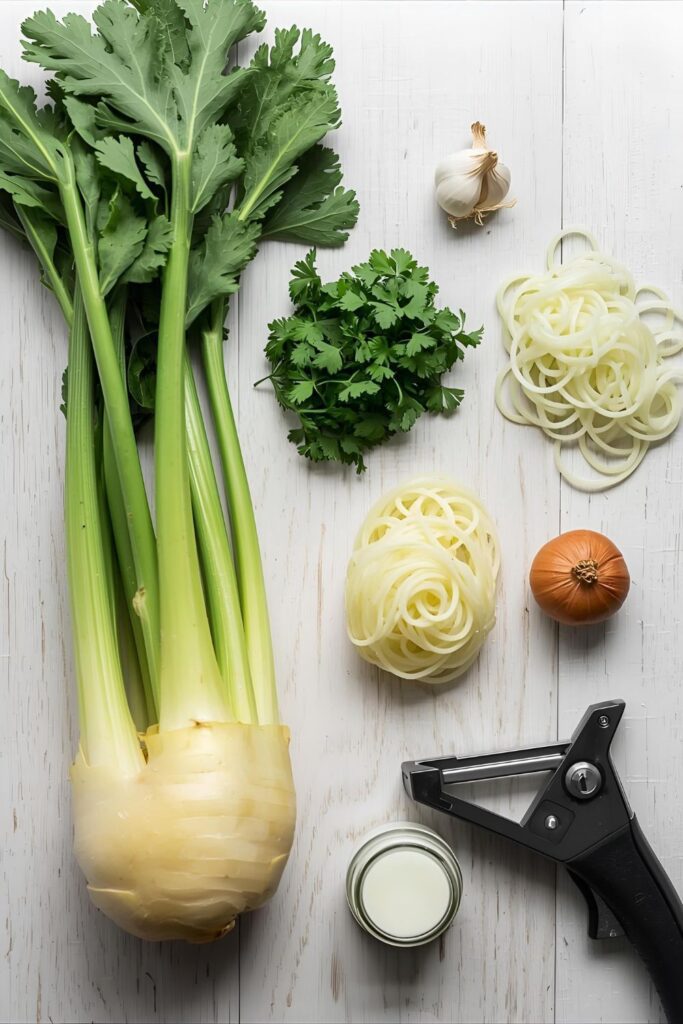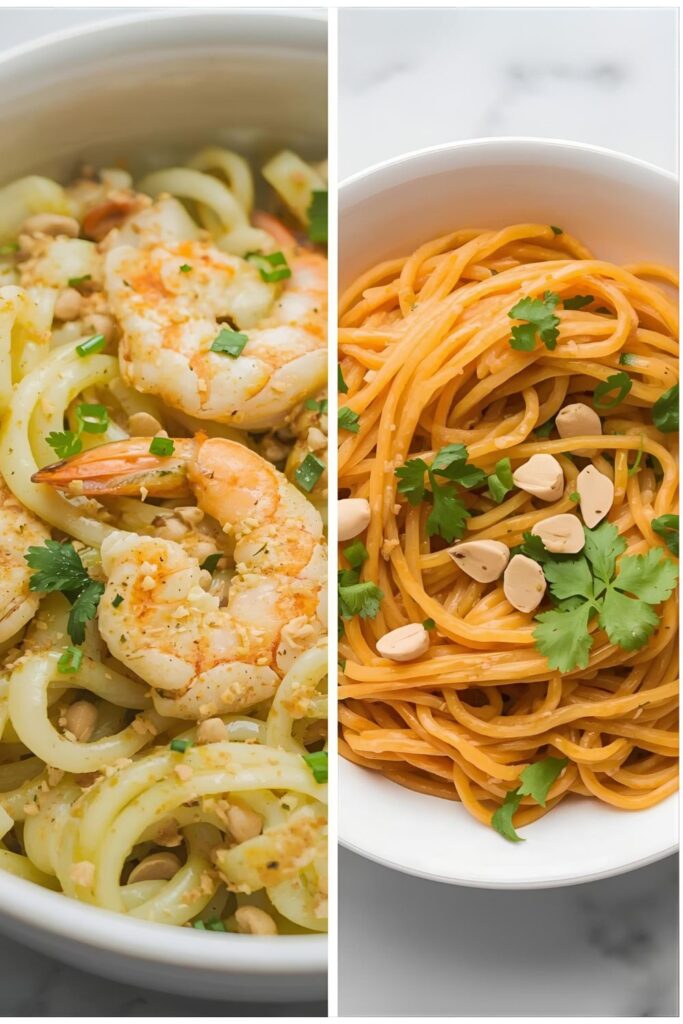Stop Zoodle Sadness: The Surprisingly Delicious Guide to Perfect Celery Root Noodles
Let’s be real for a second. We’ve all been there: standing sadly over a plate of waterlogged zucchini “pasta,” pretending we enjoy it, while secretly dreaming of a real, carb-loaded spaghetti feast. Zoodles are fine, I guess, but they lack oomph. They lack structure. They lack the satisfying chew that makes a meal feel complete. But what if I told you a root vegetable that looks like an angry, misshapen brain holds the key to the ultimate low-carb noodle? Enter Celery root noodles (or Celeriac noodles, if you’re fancy).
I know, I know. It looks intimidating. It’s rough, dirty, and generally neglected in the produce aisle. But celery root is the unsung hero of the veggie noodle world. It spirals beautifully, keeps its shape under pressure, and has a subtle, earthy, slightly nutty flavor that works with almost any sauce. Seriously, you have to try this. You’ll be canceling your pasta delivery ASAP.
Why This Recipe Is Awesome (It’s the Texture, Duh!)
You need to make these noodles because they solve the number one problem with veggie pasta: the mush factor. Unlike watery squash or delicate sweet potatoes, celeriac is dense and firm. When you cook it, it tenderizes just enough to mimic an al dente noodle. It doesn’t dissolve into sadness the second it touches hot sauce.
Beyond the perfect texture, the flavor is incredible. It’s not just “tasteless vegetable,” which is the fate of many noodle substitutes. Celery root brings a subtle, complex celery-meets-parsley root flavor that elevates whatever sauce you pair it with. You’ll impress your friends, you’ll stick to your low-carb goals, and you’ll actually enjoy your dinner. Isn’t that the dream?
🌿 The Core Ingredients You Need
We keep the ingredient list tight because nobody needs a kitchen full of random spices for a weeknight dinner.
- 1 large Celery Root (Celeriac): Look for one that feels heavy for its size. Avoid soft spots!
- 2 Tbsp. Olive Oil: For searing and flavor building. Don’t substitute with low-fat spray—we’re creating flavor here!
- 1 medium Shallot, finely minced: Shallots give a softer, sweeter flavor than harsh onion.
- 1/4 cup Dry White Wine (or Vegetable Broth): Use something you’d actually drink. The alcohol cooks off, leaving incredible depth.
- 1/4 cup Heavy Cream (or Full-Fat Coconut Milk): For a little richness, because we deserve nice things.
- Salt, Pepper, and a pinch of Nutmeg: Nutmeg is the secret weapon that elevates celeriac and cream. Trust me.
- Fresh Parsley or Chives: For garnish and a final pop of freshness.
Key Substitutions:
- No Cream? Use full-fat canned coconut milk for a rich, dairy-free sauce. It works surprisingly well!
- No Shallot? Use half a small yellow onion, but sauté it a bit longer to soften the harshness.
- Celeriac Alternative? Try rutabaga for a similar firm texture, but it has a sweeter flavor profile.
🛠️ Tools & Kitchen Gadgets Used
You need a few key pieces of kitchen hardware to conquer this gnarly root. Prep is half the battle, and these tools make it manageable.
- Heavy-Duty Vegetable Peeler: Crucial for tackling the celeriac’s thick, waxy, and often hairy skin. You cannot skip this.
- Sharp Chef’s Knife: Needed for trimming the ends and peeling the difficult areas. This root is tough, so use a good knife!
- Spiralizer (Countertop is best!): You won’t make “noodles” without one. A sturdy countertop model makes quick work of this tough vegetable.
- Large Skillet or Sauté Pan: You need a wide surface area to ensure the noodles cook evenly and quickly.
- Citrus Juicer or Lemon: For the mandatory lemon juice bath (more on that later!).
- Cutting Board: A stable, non-slip board is essential for safety when tackling this bumpy veggie.
🔪 Step-by-Step Instructions: Conquering the Celery Root
Don’t let the looks fool you. This process is simple, but requires a little muscle up front. Let’s get noodling!
Step 1: Prep the Celeriac—The Hard Part
Take a deep breath and face the celeriac. Use your sharp chef’s knife to slice off the gnarly top and bottom ends so it sits flat. Then, use the heavy-duty peeler to take off all the thick, dark skin. You must remove all the rough, waxy skin—peel until you see the pure, white interior. Cut the peeled celeriac into manageable chunks that fit your spiralizer.
Step 2: Stop the Browning & Spiralize
As soon as you peel a chunk, toss it in a bowl of cold water with a squeeze of lemon juice. This prevents the dreaded browning (oxidation is real, people!). Now, spiralize the chunks. Pro Tip: Give those long strands a quick chop with your knife so they’re easier to eat. We want noodles, not a never-ending celery root lasso.
Step 3: Build the Sauce Base
Set your large skillet over medium heat. Add the olive oil and let it warm up. Throw in the minced shallots and a pinch of salt. Sauté them for 2–3 minutes until they are soft and translucent. We want sweet, not burnt, aromatics.
Step 4: Deglaze and Add Cream
Pour in the white wine (or broth). Let it bubble and reduce for about a minute—you’re scraping up all the tasty bits from the bottom of the pan. Lower the heat slightly and stir in the heavy cream and a pinch of nutmeg. Bring the sauce to a gentle simmer.
Step 5: Cook the Celery Root Noodles
Add the celery root noodles directly into the simmering cream sauce. Toss them gently to coat. Cover the skillet and let the noodles steam and simmer for 4–6 minutes. Check them after 4; you want them to be tender but still have a firm, satisfying bite. Active voice check: You are cooking the noodles, the noodles are not being cooked by an unseen force!
Step 6: Finish and Serve
Remove the lid. Taste for seasoning and adjust the salt and pepper. If the sauce looks too thick, add a splash of broth. If it’s too thin, let it simmer uncovered for another minute. Toss in some fresh parsley or chives, and serve immediately. Delicious!
📈 Calories & Nutritional Info (Feel-Good Facts)
Eating healthy never tasted so good! Celery root gives you a lot of nutritional bang for your buck without the carb overload.
- Estimated Calories Per Serving: Around 150–180 calories (before heavy sauce additions).
- Carbs: Relatively low; approximately 12–15g of net carbs per serving. Excellent for low-carb lifestyles.
- Fiber: High in dietary fiber, which promotes digestive health. Get those good bacteria working!
- Vitamins & Minerals: A great source of Vitamin K (bone health!) and Vitamin C.
- What You’re Avoiding: The empty calories and refined starches of traditional wheat pasta. Win!
🛑 Common Mistakes to Avoid (Don’t Ruin Your Noods!)
Seriously, don’t make these mistakes. I’m telling you this as a friend who cares about your dinner.
- Not Peeling Aggressively Enough: The skin is tough, hairy, and honestly, gross. If you see any brown or green remnants, peel more! A bitter bite means you didn’t peel far enough.
- Skipping the Lemon Bath: Celeriac oxidizes fast and turns brown, which looks unappetizing. Toss peeled and spiralized noodles immediately with lemon water. This is non-negotiable.
- Overcooking the Noodles: If you cook these for too long, they lose their crucial al dente bite and become mushy. Stick to the 4–6 minute simmer and taste one before pulling them off the heat.
- Leaving the Strands Too Long: The noodles will be long enough to trip over. Chop the strands into 6-to-8-inch lengths before cooking for a better dining experience.
tweaks Variations & Customizations
Bored? Impossible, but okay! If you want to switch things up, these variations keep the core recipe fresh.
- Keto Garlic Butter Shrimp NoodlesDitch the cream and wine. Sauté the noodles in garlic butter and a squeeze of lemon. Toss in pan-seared shrimp (or chicken) and a handful of Parmesan cheese. This is a fatty, flavor-packed keto dinner winner.
- Spicy Peanut Thai-Style NoodlesGive it a Southeast Asian twist! Omit the cream sauce. Sauté the noodles with ginger, garlic, and a dash of red curry paste. Toss with a quick sauce made from peanut butter, lime juice, soy sauce (or tamari), and a splash of water. Top with cilantro and crushed peanuts. It’s a vibrant, fresh-tasting dinner.
- Vegan Mediterranean Harvest BowlSwap the cream for vegetable broth. Toss the cooked noodles with sun-dried tomatoes, roasted red peppers, Kalamata olives, and artichoke hearts. Add crumbled vegan feta and a drizzle of balsamic glaze. This turns it into a robust, satisfying vegetarian meal.
❓ FAQ Section: Your Celeriac Conundrums Solved
You have questions about this weird vegetable. I get it. Here are the most common things people ask.
What is celery root, exactly?
Celery root, or celeriac, is the root of a variety of celery. It’s not the root of the stalks you put in soup! It has a subtle celery-like flavor with nutty and earthy notes.
Is celeriac a turnip?
No, it is not a turnip. While both are root vegetables, celeriac is part of the celery family (Apiaceae), whereas turnips belong to the mustard family (Brassicaceae). They taste completely different, too.
How do I store fresh celery root?
Wrap it tightly in a paper towel, then place it in a plastic bag in the crisper drawer of your refrigerator. Store it whole and unpeeled. It should last for several weeks.
Can I eat the peel?
No, you really should not. The peel is thick, tough, waxy, and often bitter. Use a sharp knife or heavy-duty peeler to remove all of the outer skin before using the root.
Are celery root noodles a good low-carb alternative?
Absolutely! Celeriac is significantly lower in carbs than traditional pasta, potatoes, or even some other root vegetables, making it an excellent low-carb and keto-friendly noodle alternative.
Why do my celeriac noodles taste bitter?
Bitterness usually comes from not peeling the root thoroughly enough. Make sure you remove all the rough, waxy outer layer, or it will introduce a bitter taste to your dish.
Can I freeze cooked celery root noodles?
You can, but I don’t recommend it. Freezing and thawing changes the texture significantly, making them mushier than when they are fresh. It’s best to cook and enjoy them right away.
Final Thoughts (Your New Addiction Starts Now)
Seriously, if you can conquer the peeling, you can make this recipe. You just unlocked the secret to celery root noodles, the low-carb hero you never knew you needed. Go buy that weird, bumpy brain-looking thing, spiralize it, and serve it up with a hearty sauce. You’ll be so busy enjoying that perfect, al dente chew that you won’t even miss the wheat. Now go forth and conquer! And please, send me a photo of your success—I love seeing people ditch the sad zoodles. 😊







